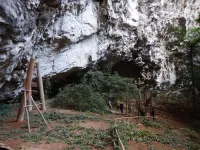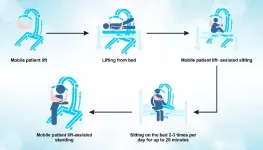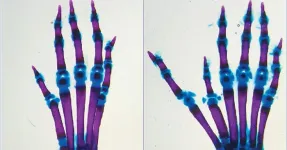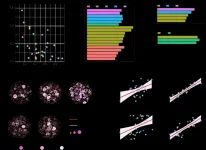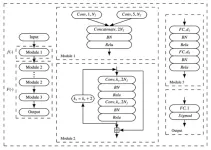(Press-News.org) Decidious and evergreen forests dominate the limestone karst formations of the northwestern highlands of Thailand. A vast number of caves and rock shelters intersperses the mountains. In over 40 such caves in Mae Hong Son province, large wooden coffins mounted on stilts, dating between 2,300 and 1,000 years ago, can be found. During the Iron Age period, each of these up to several-meter-long coffins was crafted from a single teak tree and features refined carvings of geometric, animal- or human-like shapes at the handles of both ends.
This archaeological assemblage has been studied for over two decades by members of the Prehistoric Population and Cultural Dynamics in Highland Pang Mapha Project, led by Professor Rasmi Shoocongdej, from the Department of Archaeology, Faculty of Archaeology, Silpakorn University. “Our research examines the relationship between humans and their environments in the seasonal tropics. One crucial aspect is the exploration of the social structure of these prehistoric communities, as well as explaining their connections with other pre-Neolithic, Neolithic and post-Neolithic groups in this region,” says Rasmi Shoocongdej, an archaeologist and senior author of the study.
To understand the genetic profile of the Log Coffin-associated communities, and the connection of individuals buried in different caves, an interdisciplinary team of researchers from Germany and Thailand has analyzed the DNA of 33 ancient individuals from five Log Coffin sites. The genomes recovered from the ancient individuals allow the first detailed study of the structure of a prehistoric community from Southeast Asia. “This project illustrates how ancient DNA can contribute to our understanding of past communities, their every-day life, and their cross-regional connections”, says first author Selina Carlhoff, a researcher in the Department of Archaeogenetics at the Max Planck Institute for Evolutionary Anthropology.
Complex genetic landscape in post-Neolithic mainland South East Asia
DNA preservation conditions in tropical regions are challenging and limit ancient population genetic studies from Southeast Asia. Most studies were limited to single individuals or small groups representing a country and period, and identifying only broad patterns, such as genetic admixture of farmers from the Yangtze River valley in southern China with the local Hòabìnhian hunter-gather-associated gene pool during the pre-Neolithic. The current study identifies two separate farmer-associated ancestries in the Log Coffin-associated individuals. One connected to the Yangtze River Valley, and another to the Yellow River valley in China. While previously published individuals from Myanmar, Laos and Vietnam also carry the Yellow River-related ancestry, it was absent in Bronze and Iron Age individuals from Ban Chiang in northeastern Thailand. These genetic differences mirror cultural differences between the two regions, such as mortuary practices and diet, and point towards separate influence spheres and connections to separate initial migration routes during the Neolithic period.
“Our results contribute to the emerging picture of a complex genetic landscape in post-Neolithic mainland Southeast Asia; however, this study provides successful genetic results from samples in limestone caves from the northwestern highlands of Thailand. Future studies of samples retrieved from open-air archaeological sites in the lowlands seem promising. If possible, they can provide additional insight into the genetic history of Mainland Southeast Asia,” says Wibhu Kutanan, a scientist from Naresuan University, Thailand, involved in the conception of the study. Detailed analyses of uniparental markers, which can reveal sex-specific demographic histories of Log Coffin-associated groups, will be provided in a forthcoming study. Further archaeogenetic studies in collaboration with local scholars, as well as novel admixture modelling and dating techniques, will illuminate the developing patterns better and enable direct connections to archaeological findings and hypotheses.
First community-level analysis in Southeast Asian archaeology
On the local scale, the study provided the first community-level analysis in Southeast Asian archaeology. To investigate the relations between individuals, the authors used genetic regions that are identical in two individuals, because they were inherited from a common ancestor. The analysis of so-called IBD blocks (identical-by-descent) helps tracing complex biological relatedness patterns within a site and across regions - and had so far not been applied in archaeogenetic studies of Southeast Asia. The study identified close genetic relatives buried in the same cave system, such as parents and children or grandparents and grandchildren. This cluster of closely related individuals was more distantly connected to all other individuals buried at the site.
While this suggests a selection of burial place under consideration of genetic relatedness, the more distant genetic relationships between Log Coffin sites, a low level of consanguinity, as well as high mitochondrial and low genome-wide diversity suggest that the Log Coffin-associated groups were rather large and constantly connected to each other across different river valleys. “This result is highly significant, since wooden coffins were also used in other archaeological cultures all over Southeast Asia. Comparing relatedness patterns and cross-regional genetic connections would be a fascinating future collaborative project which could potentially explain the cultural dynamics and population interactions within Southeast Asian and other regions”, says Rasmi Shoocongdej.
END
Thailand’s Iron Age Log Coffin culture
Ancient DNA helps researchers elucidate the structure of a prehistoric community from Southeast Asia
2024-02-06
ELSE PRESS RELEASES FROM THIS DATE:
Mobile patient lifts help ICU patients recover
2024-02-06
Tokyo, Japan – A recent randomized controlled trial in Tokyo, Japan, has unveiled the positive impact of early mobilization, assisted by mobile patient lifts, on the recovery of ventilated intensive care unit (ICU) patients. The debate surrounding the efficacy of early mobilization in ICU has persisted for an extended period.
The treatment of critically ill patients in ICUs, often involving prolonged limb immobilization or restricted mobility, is acknowledged as a risk factor for diminished physical strength and diminished quality of life post-recovery, ...
Re-excision rates after breast-conserving surgery pose ongoing challenges in the US: UTHealth Houston study unveils high reoperation rates and costs
2024-02-06
Rates of re-excision after initial breast-conserving surgery in women with breast cancer remain high across the United States, leading to an increased cost of care and a higher risk of postoperative complications, according to new research from UTHealth Houston.
The study, led by first author Youngran Kim, PhD, assistant professor; and senior author Trudy Krause, PhD, professor, was published today in Annals of Surgical Oncology. Both are with the Center for Health Care Data in the Department of Management, Policy ...
Extra fingers and hearts: pinpointing changes to our genetic instructions that disrupt development
2024-02-06
Our genomes provide the instructions for proper growth and development. Millions of genomic switches, known as enhancers, control the location and timing of gene expression, which in turn ensures the correct proteins are made in the right cells at the right time throughout our lives. New research from University of California San Diego Assistant Professor Emma Farley’s lab shows how we can now predict which single base-pair changes to the DNA within our genomes will alter these instructions and disrupt development, causing extra digits and hearts.
We now ...
A common add-on in IVF may be an expensive waste of time, study in Lancet reveals
2024-02-06
One of the most common add-ons to IVF procedures undertaken in Australia and globally by infertile couples may be a waste of time as well as expensive and invasive, and maye even reduce the chances of success, according to a new report in The Lancet.
The research, by Monash University’s Professor Ben Mol in Australiaa and Dr. Rui Wang and colleagues in China, found that intracytoplasmic sperm injection (ICSI) whereby a single sperm is injected directly into a mature egg – originally developed in 1992 for couples with severe male infertility but which has since expanded ...
Males born to obese mothers more likely to suffer health issues as adults
2024-02-06
Males born to obese women are more likely to be overweight at birth and develop metabolic complications in later life, including liver disease and diabetes.
The way that male sex hormones activate pathways in the developing liver is partly to blame.
That’s the finding from a new study led by University of South Australia (UniSA) researchers looking at the impact of maternal obesity on fetal liver androgen signalling.
Male fetuses of obese pregnant women have different signals that are activated by male sex hormones in the liver, which encourages them to prioritise growth at the expense of their health.
UniSA researcher Dr Ashley Meakin ...
Contrasting response of rice rhizosphere microbiomes to in situ cadmium-contaminated soil remediation
2024-02-06
Understanding the responses of different rhizosphere microbial lineages to soil amendments during in situ remediation of Cd-contaminated soil is of great importance in the assessment of the restoration and crop health. This study demonstrates the distinct responses of rice rhizosphere microbial communities to soil amendment applications, highlighting the interactive associations between microbiomes, which is vital for enhancing our ability to develop effective strategies for sustainable soil management. The researchers' findings appeared December 4, 2023 in Soil Ecology Letters.
A series ...
Chemoradiotherapy patients are more likely to have multiple infections and encouraged to start antibiotic therapy immediately for early intervention
2024-02-06
Pulmonary malignancy is one of the most frequent and fatal cancers in older patients. Studies have shown that lung cancer patients have a high incidence of lower respiratory tract infections. This is due to the fact that these patients usually have airway obstruction, sticky sputum that is not easy to cough up, destruction of mucosal surfaces, and treatment with radiotherapy and chemotherapy. When most patients are found to have lung cancer, they have already developed distal metastasis and lost the chance of surgery, therefore, they usually choose to be treated with radiotherapy, chemotherapy, and targeted drugs. Radiotherapy and chemotherapy ...
Fatty acids hold clue to creating memories
2024-02-06
Researchers at the University of Queensland have revealed the crucial role of saturated fatty acids in the brain’s consolidation of memories.
Dr Isaac Akefe from UQ’s Queensland Brain Institute has uncovered the molecular mechanism and identified the genes underlying the memory creation process, opening the door to a potential treatment for neurodegenerative disorders.
“We’ve shown previously that levels of saturated fatty acids increase in the brain during neuronal communication, but we ...
Improved differential-neural cryptanalysis for round-reduced Simeck32/64
2024-02-06
Deep learning has led to great improvements recently on a number of difficult tasks.
In CRYPTO 2019, Gohr innovatively integrated deep learning with differential cryptanalysis, specifically applied to Speck32/64, resulting in developing a neural distinguisher that outperforms the DDT-based distinguisher. Applying differential neural cryptanalysis methods to more cryptographic algorithms is an issue worth studying.
To solve the problems, a research team led by Liu ZHANG published their new research on 15 Dec 2023 in Frontiers of Computer Science co-published by Higher Education Press ...
Heavy cannabis use increases risk of developing an anxiety disorder, study suggests
2024-02-06
Ottawa, ON, February 5, 2024 – Twenty-seven percent of individuals who had an emergency department visit for cannabis use developed a new anxiety disorder within three years, according to new research.
Led by researchers at the Bruyère Research Institute, University of Ottawa Department of Family Medicine, The Ottawa Hospital, and ICES, this is the largest study of the relationship between cannabis use and anxiety to date. The study published today in The Lancet’s open access journal eClinical Medicine included over 12 million individuals living in Ontario, Canada, between 2008 and 2019 who had never received a diagnosis or treatment for anxiety. The researchers ...
LAST 30 PRESS RELEASES:
Making lighter work of calculating fluid and heat flow
Normalizing blood sugar can halve heart attack risk
Lowering blood sugar cuts heart attack risk in people with prediabetes
Study links genetic variants to risk of blinding eye disease in premature infants
Non-opioid ‘pain sponge’ therapy halts cartilage degeneration and relieves chronic pain
AI can pick up cultural values by mimicking how kids learn
China’s ecological redlines offer fast track to 30 x 30 global conservation goal
Invisible indoor threats: emerging household contaminants and their growing risks to human health
Adding antibody treatment to chemo boosts outcomes for children with rare cancer
Germline pathogenic variants among women without a history of breast cancer
Tanning beds triple melanoma risk, potentially causing broad DNA damage
Unique bond identified as key to viral infection speed
Indoor tanning makes youthful skin much older on a genetic level
Mouse model sheds new light on the causes and potential solutions to human GI problems linked to muscular dystrophy
The Journal of Nuclear Medicine ahead-of-print tip sheet: December 12, 2025
Smarter tools for peering into the microscopic world
Applications open for funding to conduct research in the Kinsey Institute archives
Global measure underestimates the severity of food insecurity
Child survivors of critical illness are missing out on timely follow up care
Risk-based vs annual breast cancer screening / the WISDOM randomized clinical trial
University of Toronto launches Electric Vehicle Innovation Ontario to accelerate advanced EV technologies and build Canada’s innovation advantage
Early relapse predicts poor outcomes in aggressive blood cancer
American College of Lifestyle Medicine applauds two CMS models aligned with lifestyle medicine practice and reimbursement
Clinical trial finds cannabis use not a barrier to quitting nicotine vaping
Supplemental nutrition assistance program policies and food insecurity
Switching immune cells to “night mode” could limit damage after a heart attack, study suggests
URI-based Global RIghts Project report spotlights continued troubling trends in worldwide inhumane treatment
Neutrophils are less aggressive at night, explaining why nighttime heart attacks cause less damage than daytime events
Menopausal hormone therapy may not pose breast cancer risk for women with BRCA mutations
Mobile health tool may improve quality of life for adolescent and young adult breast cancer survivors
[Press-News.org] Thailand’s Iron Age Log Coffin cultureAncient DNA helps researchers elucidate the structure of a prehistoric community from Southeast Asia
